|
Capacity and quality are rising sharply on European tissue markets and the battle between private and branded tissue is worth watching closely
by Hugh O'Brian
A tale of two labels: private or branded tissue
It was the best of times, it was the worst of times, it was the age of wisdom, it was the age of foolishness, it was the epoch of belief, it was the epoch of incredulity . . ." This famous quote from A Tale of Two Cities was written by Charles Dickens in 1859. But considering the present turbulent situation, one could equally apply the description to today's European tissue market.
Never before has this market faced such uncertain times, with the big players getting bigger, small niche players finding success, new capacity being built at a scary rate and sharply rising quality appearing - mainly due to the introduction of more through air dried (TAD) machines.
Add to this the increasing importance of private label tissue as the power of the large retail chains increases, and one can see that the turbulence will probably continue for the foreseeable future. The winners may well be European consumers who can most probably look forward to rising quality levels and more competition for their business.
The European tissue market has grown by around 4% per annum during the 1990s and total production now amounts to slightly over 5 million tons. The latest available data, based on 1997 production statistics, puts production at 5 million tons, up from 3.8 million tons in 1990. With all the new machines coming on stream, it is estimated that European tissue capacity will reach 6 millions tons by the end of 2000.
Southern Europe has seen the largest growth in tissue output, with Italy by far the leader in adding new capacity during the 1990s. For several reasons official Italian production statistics seriously underestimate the true tissue output. Best estimates put Italian domestic tissue capacity at 1.2-1.3 million tons, which means that output has doubled since 1990 and makes Italy the largest tissue producer in Europe.
Other southern European countries such as France and Spain have also seen large capacity increases during this decade. On the other hand, the largest tissue consuming market in Europe - Germany - has witnessed very little growth in production capacity during the 1990s. As a result, Germany has moved from the number one European tissue maker to number two, after Italy. Even though German production has grown very little, consumption has increased by an estimated 300,000 tons/yr. The increased demand has been made up mainly through imports from Italy, which shipped an estimated 180,000 tons of tissue products to Germany in 1997.
Italian mills also exported large quantities of tissue to France in 1997, but this figure is expected to decrease in the coming years as numerous Italian companies are building paper mills in France to supply their local converting plants.
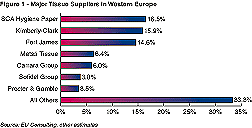
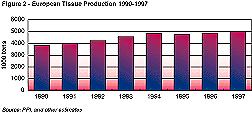
The big bulge
New tissue capacity is flooding into the market at an unprecedented rate. EU Consulting (EUC) estimates that the net rise in production in Western Europe was 120,000 tons in 1998. This year, the group anticipates an additional 250,000 tons, while EUC forecasts 300,000 tons of new tissue capacity coming on to the market in 2000. Obviously this has raised serious concerns about overcapacity and falling utilization rates. This capacity problem, along with new pushes from American giants such as Procter & Gamble into the European market, mean fierce competition over the coming years.
The biggest capacity increases will come in 1999, with new tonnage being phased into the market during 1999-2000. SCA will add a new 70,000 ton/yr machine using through air dried (TAD) technology at Mannheim in Germany, which will be dedicated primarily to kitchen towels. P&G will install a similar-sized TAD PM near Manchester in the UK, which will also be focused on kitchen towels. Both of these machines will start up late in 1999. AM Paper's 30,000 tons/yr machine, which started late last year in Skelmersdale near Manchester in the UK, is also making TAD product.
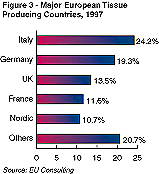
Italian tissue producers continue to add new machines at an astonishing rate, both at home in Italy and in other European countries such as France and Spain. In the most recent display of the Italians' desire to become more international, the CartoInvest Group recently made its first move into the UK through the purchase of the Oakenholt tissue mill in North Wales. CartoInvest plans to add two new 20,000 ton/yr tissue PMs in 2000-2001.
Overall, Italian companies will raise their tissue capacity by an estimated 400,000-500,000 tons/yr during the 1998-2000 period, with about half of that chunk of capacity being added in France and Spain. Of the new Italian capacity, much of it will be destined for export to retailers in Germany, Switzerland and elsewhere. The growth of the Italian tissue producers, and their willingness to make private label tissue for retail chains in Europe, has been a major factor driving strong private label growth during the 1990s.
With Western European per capita consumption levels approaching an average of around 12 kg and growth rates projected to taper off, Eastern Europe is looking fairly promising. The financial instability in Eastern Europe (especially Russia) makes any investment a risky prospect, but the market potential is great enough the draw the interest of numerous players. For example, per capita consumption in Eastern Europe is currently only around 2 kg, while in Sweden it is 17 kg and in the USA it is 22 kg. Clearly, there is room for growth in the region and we can expect to see European tissue makers and multinational corporations taking a closer look at Eastern Europe, particularly the more developed countries such as Poland, Hungary and the Czech Republic.
In the short term, Eastern Europe may serve as an outlet for excess tonnage produced in Western Europe. But as living standards climb and tissue demand grows, investment in new capacity is expected to feature across the region.
Retail wrangles
Europe is becoming a much more competitive market as the various tissue suppliers battle it out for market share. On the consumer tissue side especially (as opposed to the away-from-home or institutional sector), the business is becoming fiercely competitive. Quality issues are increasing in importance as producers see this as the way to distinguish their products from all the others on supermarket shelves.
The grocery retailing business is undergoing massive change throughout Europe. This is true not only for tissue, but for all product sectors. Retailers are facing up to increasing pressure on several fronts, including:
- the prospect of limited sales growth in mature markets
- increasing competition due to the internationalization of the larger and medium-sized players
- limited loyalty and increasing sophistication of customers
- continuing price pressure from discount suppliers.
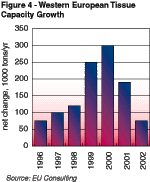
Recent data from AC Nielsen shows that discount suppliers have gained market share in all Western European countries over the past six years. This is also the case in Eastern Europe where established discount groups such as Metro, Rewe and Tengelmann have rolled out their own-store formats. Metro has set up hypermarkets and discount outlets in Poland, while Rewe has exported its discount format to Hungary and the Czech Republic. Tengelmann has also established discount stores in Poland the Czech Republic.
Bountiful supplies
In this highly competitive environment, tissue producers looking to fuel growth have started playing the quality card in Europe as never before. The best example in recent memory is the rollout of Procter & Gamble's 'Bounty' brand kitchen towel in Europe in 1997. Bounty is produced using the TAD process in the USA. It has proved tremendously successful in that market over the past two decades or more, becoming a top selling premium kitchen towel. P&G came into the German market in early 1997, launching Bounty with a massive advertising and promotion campaign.
It should be pointed out that the Bounty launched on the European market in 1997 was not a TAD product, but it certainly was a premium, enhanced quality product. Unofficial estimates indicate that P&G spent DM 47 million during 1997 to launch Bounty, while total sales of the product were estimated at DM 40 million. Backed by this promotion machine, Bounty quickly grabbed 20% or more of the German kitchen towel market.
With kitchen (or household) towel consumption in Germany running at 1.2 kg per capita in 1997, German consumers lag way behind the USA (4 kg) or Sweden (2 kg). Consequently, there is a lot of room for consumption growth. This is especially apparent given the boost generated by the launch of Bounty. The German kitchen towel market grew by a rather astonishing 8.3% in 1997, compared with 1996. This was up sharply from the 3% growth recorded in 1996 and the meager 0.9% growth witnessed in 1995. This demonstrates that Bounty was not only a success for P&G, but a success for all suppliers to the German kitchen towel market.
The increasing acceptance of higher quality tissue, and indeed the expectation that tissue quality should continue to rise, will be a major driving force in Europe over the coming years. The success of Bounty shows the importance of technical innovation both for "branded" products such as Bounty, as well as for the so-called "private label" products, which are more correctly referred to as "retailer brands". All signs point to the increasing importance of innovation and cutting-edge technical product developments over the coming decade.
With quality levels moving up and technology such as TAD now widely available, it is clear that the retailers are going to start using quality as a competitive tool. Indeed, this has already happened in several countries as retail chains have demanded higher-quality three and four ply tissue products. For example, in Germany it is estimated that three and four ply products have two thirds of the toilet paper market today, up from one third in 1992. It is also clear that as more 'independent' TAD tonnage becomes available from suppliers such as AM Paper in the UK, the sector can expect to see more premium private label tissue appearing on supermarket shelves. However, at this point it is not clear how much new TAD tonnage will be available in the short term.
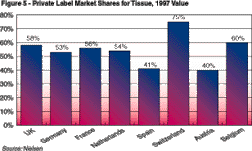
Premium products
There are several factors at work in the sector today. Not least of these is the desire of retailers to hold on to market share, which seems in danger of being lost to premium branded products. Having built up their private label tissue products into important profit generators, the retailers are certainly not going to let P&G, or any branded producer, push their private label tonnage off the shelf. To fight back they are looking for the best quality tonnage they can buy. Of course, they also want to secure this quality at good prices so that they can keep a cost advantage with respect to the premium branded products.
Interviews with retailers clearly show that premium products are expected to be the fastest growing tissue segment in the coming years. The retailers expect both premium branded product (eg Bounty) as well as premium private label product to grow at the expense of the low-end segment and secondary brands. In other words, assuming that the retailers know what they are talking about, they do not see any growth at all for products at the lower end of the scale. The only products they believe will move on supermarket shelves are premium grades such as multi-ply and TAD products.
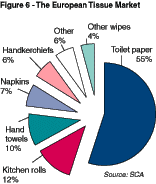
The fight between private label tissue and branded products is far from over. Private label tonnage has grown sharply over the past decade due to several factors, including the dominant position of retailers, the lower price of private labels and the willingness of independent mills such as the Italians to make good quality tissue stock for private label products.
Private label market share is now at extremely high levels in some countries. Nielsen data indicates a level of 75% in Switzerland, for example. But it is hard to believe that the market share for private labels will grow much more. In addition, branded product suppliers seem more committed than ever to defending their market share and even clawing back some of what they have lost.
A TAD Italian?
The issue of supply is naturally an important one. Once again, the Italian mills will be key players in this developing scenario as they have few brands of their own and form the major suppliers to retail chains throughout Europe. But it is not yet clear if the Italian mills have the resources necessary to remain stand-alone players and also follow the quality developments, especially TAD.
Italy's tissue makers are certainly good papermakers, but the money and expertise that TAD requires may make them less willing to follow this market trend. However, if the independent Italians do choose to go for TAD, then it seems clear that private label TAD will be abundantly available relatively soon.
At this point, the only independent producer making TAD product is AM Paper. Last year, AM secured a big order from the UK retailer, Asda, reportedly taking the business away from Kimberly-Clark in the process. Ironically, before the AM Paper machine started up, the company initially bought jumbo rolls of TAD tissue from - of all companies - Kimberly-Clark de Mexico.
SCA and K-C are making products for both the branded and private label sectors. K-C has had rather well publicized troubles trying to make money on its European operations. To improve profits, K-C tried to move more of its business to the higher priced branded market, taking tonnage away from the private label sector. SCA, on the other hand, appears committed to both branded products as well as the private label market. With the large, new tissue machine at Mannheim in Germany starting late next year based on TAD technology, it will be interesting to see exactly how much of that TAD tonnage ends up as private label stock.
With P&G starting its TAD line at Manchester in the UK later this year, one can expect that the European Bounty will move over to TAD. If so, it would be logical to assume there will be an accompanying massive promotion campaign to announce the new 'softer and thirstier' Bounty, which could well give another shot in the arm to the European kitchen towel market. One has to wonder if, or when, P&G will come in with a supersoft toilet tissue in Europe similar to its Charmin brand in the USA.
With all these factors influencing the European market, change is certainly in the air. Inevitably, it will be the best of times for some and the worst of times for others.
|